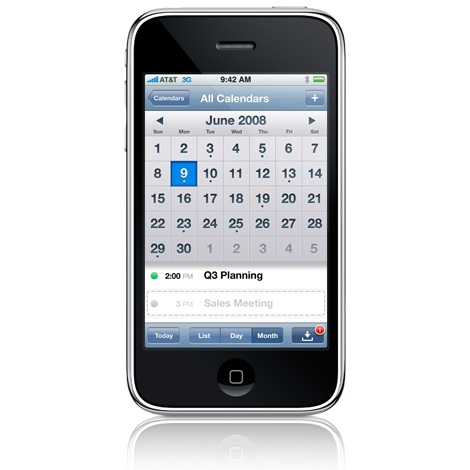Top 10 lessons for iPhone adoption in the enterprise


New Forrester research suggests that Apple's iPhone is a worthy platform for delivering content and collaboration applications to an increasingly mobile workforce -- and that there's a case to be made for adopting the iPhone in the enterprise.
It wasn't always that way: only a year ago, Forrester gave IT pros 10 reasons why they shouldn't adopt the iPhone.
A lot changes in a year.
This time, Forrester interviewed two vendors and three user companies -- Apple, Kraft Foods, Oracle, Notify Technology and a California-based pharmaceutical company -- to figure out the benefits and drawbacks of implementing the iPhone at the company.
According Kraft, Oracle and the pharma company, the good outweighs the bad. Each company had a different reason to implement the device:
- Kraft Foods: Driving culture change. Kraft uses iPhone support to demonstrate that IT is serious about supporting culture change. The company was a part of Apple's iPhone enterprise beta program in April 2008, and as of January 2009, almost half of Kraft Foods’ mobile users have iPhones, with about 400 new iPhones ordered each month.
- Oracle: Employee demand. Employees began asking for email and calendar support for iPhones they bought themselves, and Oracle was able to respond using the open standards included in its own Beehive collaboration software. iPhone's support for IMAP and SMTP streamlined the rollout, and the upcoming support for CalDAV in iPhone 3.0 will help further. The company now has 4,000 iPhone users globally.
- A pharmaceutical company: An internal advocate. Thanks to the company's IT senior director, the iPhone has become the company's "enterprise netbook," with support for the campuswide wireless network. With Apple's support for ActiveSync with iPhone 3G, it took the company three days to get the systems running to support the device. The company saw significant cost savings for data and voice plans.
Should your company adopt the iPhone? Is the device ready for the enterprise? The answer's yes, according to the survey.
Here are the top 10 lessons of iPhone adoption in the enterprise:
1.) It's more than just another device
Mobile collaboration opportunities are greater on iPhone, thanks to a better user experience and a growing developer tool kit and ecosystem. The Internet feels natural on an iPhone and like a chore on a BlackBerry, and document viewing, WebEx presentations and Internet access is just better on the iPhone. As developers build new applications for SharePoint access, data analysis, multiway conferencing, and training, the workforce can leave their laptops at work.2.) It gives employees freedom to choose their own tools
Sometimes it just makes sense to give employees the freedom to choose the tools they want. If an iPhone makes an employee happy, then supporting it will deliver collateral benefits of a happier workforce and a new line of communication between IT and employees.3.) It changes the support model to self-service
Community-led iPhone support can mean lower support costs. Your internal iPhone community can support itself if you provide a moderated wiki (to keep inappropriate security workarounds from being widely shared). Your own help desk can contribute its expertise to the community support site.4.) It can save money
A hard look at the data and voice plans sometimes reveals hidden savings. In at least one case, an iPhone adopter found that the data plans for previous mobile devices were more expensive than the consumer plans AT&T is offering for iPhones. This company was able to reset its baseline plan pricing 30 percent lower for all phones because it supported the iPhone.5.) It helps IT stay out of the device & mobile plan business
When an employee buys an iPhone, he or she gets hardware and accessories from the Apple Store. That's good for enterprise IT. And with the standardized pricing of iPhone services from AT&T, you can stay out of the plan business as well. You have, in effect, outsourced responsibility for the device, network, and plan to others, while retaining control over device policies and management.6.) It allows IT to use policy profiles to implement security requirements
In some of the companies Forrester interviewed, employees who purchase their own phones, including iPhones, had to sign an agreement to abide by the firms' security policies (PINs to access the device, 90-day recertification, agreement to allow a remote wipe if leaving the company, etc.) VPN configuration, digital certificates, and other policy information is automatically configured when an employee first sets up his or her iPhone.7.) It allows IT to adopt self-provisioning for apps and configuration
Apple has made configuration and application tools available wirelessly through a URL. This gives enterprises a scalable way to walk users through a self-provisioning and installation process. Though some applications -- like Cisco's WebEx, Oracle Business Indicators and Salesforce Mobile -- are available through Apple's AppStore, the best way to put a corporate application or digital certificate on an iPhone is through a portal link or a URL sent through email or SMS.8.) iPhone and ActiveSync is a work in progress for calendaring
This is the single biggest enterprise end user problem that Forrester identified, and until Apple and Microsoft figure out how to make this work for both Exchange 2003 and Exchange 2007, it's "buyer beware." iPhone 3.0 may address this problem.9.) A lack of management tools and full support for VPNs may be a deal-breaker
Compared to BlackBerry Enterprise Server, management and guaranteed message delivery tools for iPhone are weak. Moreover, iPhone 2.x provides native Cisco IPsec VPN support, but password caching and a requirement to explicitly invoke the VPN may make it a nonstarter to let iPhones inside the firewall. This may be fixed with iPhone 3.0.10.) Early-generation tech butterflies make for a frustrating user experience
Cut and paste, landscape mode for email; click-to-call and Flash support are all sorely missed. Some will be fixed with iPhone 3.0.The full report can be found on Forrester's site.
What lessons do you have for iPhone adoption in the enterprise?